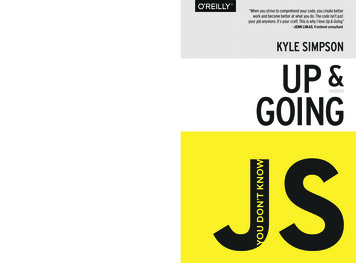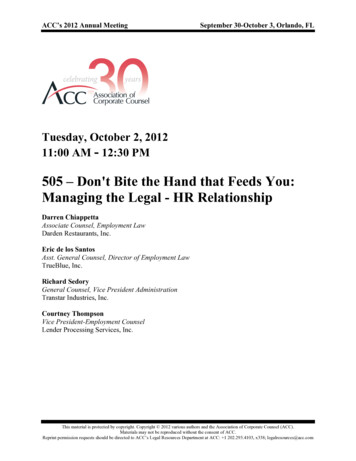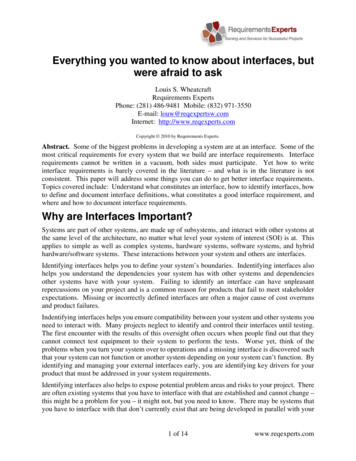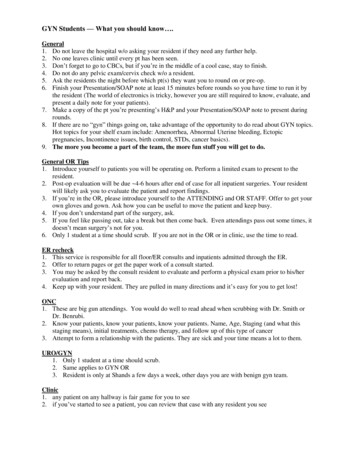
Transcription
The YOU DON’T KNOW JS series includes: Up & GoingScope & Closuresthis & Object PrototypesTypes & GrammarAsync & PerformanceES6 & BeyondKYLE SIMPSON IIt’s easy to learn parts of JavaScript, but much harder to learn it completely—or evensufficiently—whether you’re new to the language or have used it for years. With the “You Don’tKnow JS” book series, you’ll get a more complete understanding of JavaScript, including trickierparts of the language that many experienced JavaScript programmers simply avoid.The series’ first book, Up & Going, provides the necessary background for those of you withlimited programming experience. By learning the basic building blocks of programming, aswell as JavaScript’s core mechanisms, you’ll be prepared to dive into the other, more in-depthbooks in the series—and be well on your way toward true JavaScript. Learn the essential programming building blocks, including operators, types,variables, conditionals, loops, and functions Become familiar with JavaScript’s core mechanisms, such as values, functionclosures, this, and prototypes Get an overview of other books in the series—and learn why it’s important tounderstand all parts of JavaScriptKyle Simpson is an Open Web evangelist from Austin, TX, who’s passionate about all things JavaScript.He’s an author, workshop trainer, tech speaker, and OSS contributor/leader.Twitter: @oreillymediafacebook.com/oreillyUS 4.99CAN 5.99ISBN: 978-1-491-92446-4oreilly.comYouDontKnowJS.comUP & GOINGWith this book you will:YOU DON’T KNOW JAVASCRIPTUP & GOINGJAVA SCRIPTJAVASCRIPT“When you strive to comprehend your code, you create betterwork and become better at what you do. The code isn’t justyour job anymore, it’s your craft. This is why I love Up & Going.”—JENN LUKAS, Frontend consultantKYLE SIMPSON&UPIGOING
The YOU DON’T KNOW JS series includes: Up & GoingScope & Closuresthis & Object PrototypesTypes & GrammarAsync & PerformanceES6 & BeyondKYLE SIMPSON IIt’s easy to learn parts of JavaScript, but much harder to learn it completely—or evensufficiently—whether you’re new to the language or have used it for years. With the “You Don’tKnow JS” book series, you’ll get a more complete understanding of JavaScript, including trickierparts of the language that many experienced JavaScript programmers simply avoid.The series’ first book, Up & Going, provides the necessary background for those of you withlimited programming experience. By learning the basic building blocks of programming, aswell as JavaScript’s core mechanisms, you’ll be prepared to dive into the other, more in-depthbooks in the series—and be well on your way toward true JavaScript. Learn the essential programming building blocks, including operators, types,variables, conditionals, loops, and functions Become familiar with JavaScript’s core mechanisms, such as values, functionclosures, this, and prototypes Get an overview of other books in the series—and learn why it’s important tounderstand all parts of JavaScriptKyle Simpson is an Open Web Evangelist from Austin, TX, who’s passionate about all things JavaScript.He’s an author, workshop trainer, tech speaker, and OSS contributor/leader.Twitter: @oreillymediafacebook.com/oreillyUS 4.99CAN 5.99ISBN: 978-1-491-92446-4oreilly.comYouDontKnowJS.comUP & GOINGWith this book you will:YOU DON’T KNOW JAVASCRIPTUP & GOINGJAVA SCRIPTJAVASCRIPT“When you strive to comprehend your code, you create betterwork and become better at what you do. The code isn’t justyour job anymore, it’s your craft. This is why I love Up & Going.”—JENN LUKAS, Frontend consultantKYLE SIMPSON&UPIGOING
Up & GoingKyle Simpson
Up & Goingby Kyle SimpsonCopyright 2015 Getify Solutions. All rights reserved.Printed in the United States of America.Published by O’Reilly Media, Inc., 1005 Gravenstein Highway North, Sebastopol, CA95472.O’Reilly books may be purchased for educational, business, or sales promotional use.Online editions are also available for most titles (http://safaribooksonline.com). Formore information, contact our corporate/institutional sales department:800-998-9938 or corporate@oreilly.com.Editors: Simon St.Laurent and BrianMacDonaldProduction Editor: Kristen BrownCopyeditor: Jasmine KwitynApril 2015:Proofreader: Amanda KerseyInterior Designer: David FutatoCover Designer: Karen MontgomeryIllustrator: Rebecca DemarestFirst EditionRevision History for the First Edition2015-03-17: First ReleaseSee http://oreilly.com/catalog/errata.csp?isbn 9781491924464 for release details.The O’Reilly logo is a registered trademark of O’Reilly Media, Inc. You Don’t KnowJS: Up & Going, the cover image, and related trade dress are trademarks of O’ReillyMedia, Inc.While the publisher and the author have used good faith efforts to ensure that theinformation and instructions contained in this work are accurate, the publisher andthe author disclaim all responsibility for errors or omissions, including without limi‐tation responsibility for damages resulting from the use of or reliance on this work.Use of the information and instructions contained in this work is at your own risk. Ifany code samples or other technology this work contains or describes is subject toopen source licenses or the intellectual property rights of others, it is your responsi‐bility to ensure that your use thereof complies with such licenses and/or rights.978-1-491-92446-4[LSI]
Table of ContentsForeword. . . . . . . . . . . . . . . . . . . . . . . . . . . . . . . . . . . . . . . . . . . . . . . . . . . . . . vPreface. . . . . . . . . . . . . . . . . . . . . . . . . . . . . . . . . . . . . . . . . . . . . . . . . . . . . . . vii1. Into Programming. . . . . . . . . . . . . . . . . . . . . . . . . . . . . . . . . . . . . . . . . . . 1CodeExpressionsTry It YourselfOperatorsValues & TypesCode racticeReview23481012141718202226282. Into JavaScript. . . . . . . . . . . . . . . . . . . . . . . . . . . . . . . . . . . . . . . . . . . . . 29Values & TypesVariablesConditionalsStrict ModeFunctions as Valuesthis IdentifierPrototypes30404345475253iii
Old & NewNon-JavaScriptReview5558593. Into YDKJS. . . . . . . . . . . . . . . . . . . . . . . . . . . . . . . . . . . . . . . . . . . . . . . . . 61Scope & Closuresthis & Object PrototypesTypes & GrammarAsync & PerformanceES6 & BeyondReview616263646567A. Acknowledgments. . . . . . . . . . . . . . . . . . . . . . . . . . . . . . . . . . . . . . . . . . 69iv Table of Contents
ForewordWhat was the last new thing you learned?Perhaps it was a foreign language, like Italian or German. Or maybeit was a graphics editor, like Photoshop. Or a cooking technique orwoodworking or an exercise routine. I want you to remember thatfeeling when you finally got it: the lightbulb moment. When thingswent from blurry to crystal clear, as you mastered the table saw orunderstood the difference between masculine and feminine nounsin French. How did it feel? Pretty amazing, right?Now I want you to travel back a little bit further in your memory toright before you learned your new skill. How did that feel? Probablyslightly intimidating and maybe a little bit frustrating, right? At onepoint, we all did not know the things that we know now, and that’stotally OK; we all start somewhere. Learning new material is anexciting adventure, especially if you are looking to learn the subjectefficiently.I teach a lot of beginner coding classes. The students who take myclasses have often tried teaching themselves subjects like HTML orJavaScript by reading blog posts or copying and pasting code, butthey haven’t been able to truly master the material that will allowthem to code their desired outcome. And because they don’t trulygrasp the ins and outs of certain coding topics, they can’t write pow‐erful code or debug their own work because they don’t really under‐stand what is happening.I always believe in teaching my classes the proper way, meaning Iteach web standards, semantic markup, well-commented code, andother best practices. I cover the subject in a thorough manner toexplain the hows and whys, without just tossing out code to copyv
and paste. When you strive to comprehend your code, you createbetter work and become better at what you do. The code isn’t justyour job anymore, it’s your craft. This is why I love Up & Going. Kyletakes us on a deep dive through syntax and terminology to give agreat introduction to JavaScript without cutting corners. This bookdoesn’t skim over the surface but really allows us to genuinelyunderstand the concepts.Because it’s not enough to be able to duplicate jQuery snippets intoyour website, the same way it’s not enough to learn how to open,close, and save a document in Photoshop. Sure, once I learned a fewbasics about the program, I could create and share a design I made.But without legitimately knowing the tools and what is behindthem, how can I define a grid, or craft a legible type system, or opti‐mize graphics for web use. The same goes for JavaScript. Withoutknowing how loops work, or how to define variables, or what scopeis, we won’t be writing the best code we can. We don’t want to settlefor anything less—this is, after all, our craft.The more you are exposed to JavaScript, the clearer it becomes.Words like closures, objects, and methods might seem out of reachto you now, but this book will help those terms come into clarity. Iwant you to keep those two feelings of before and after you learnsomething in mind as you begin this book. It might seem daunting,but you’ve picked up this book because you are starting an awesomejourney to hone your knowledge. Up & Going is the start of our pathto understanding programming. Enjoy the lightbulb moments!—Jenn Lukas (http://jennlukas.com, @jennlukas),Frontend consultantvi Foreword
PrefaceI’m sure you noticed, but “JS” in the series title is not an abbrevia‐tion for words used to curse about JavaScript, though cursing at thelanguage’s quirks is something we can probably all identify with!From the earliest days of the Web, JavaScript has been a founda‐tional technology that drives interactive experience around the con‐tent we consume. While flickering mouse trails and annoying popup prompts may be where JavaScript started, nearly two decadeslater, the technology and capability of JavaScript has grown manyorders of magnitude, and few doubt its importance at the heart ofthe world’s most widely available software platform: the Web.But as a language, it has perpetually been a target for a great deal ofcriticism, owing partly to its heritage but even more to its designphilosophy. Even the name evokes, as Brendan Eich once put it,“dumb kid brother” status next to its more mature older brother,Java. But the name is merely an accident of politics and marketing.The two languages are vastly different in many important ways.“JavaScript” is as related to “Java” as “Carnival” is to “Car.”Because JavaScript borrows concepts and syntax idioms from sev‐eral languages, including proud C-style procedural roots as well assubtle, less obvious Scheme/Lisp-style functional roots, it is exceed‐ingly approachable to a broad audience of developers, even thosewith little to no programming experience. The “Hello World” ofJavaScript is so simple that the language is inviting and easy to getcomfortable with in early exposure.While JavaScript is perhaps one of the easiest languages to get upand running with, its eccentricities make solid mastery of the lan‐guage a vastly less common occurrence than in many other lan‐vii
guages. Where it takes a pretty in-depth knowledge of a languagelike C or C to write a full-scale program, full-scale productionJavaScript can, and often does, barely scratch the surface of what thelanguage can do.Sophisticated concepts that are deeply rooted into the language tendinstead to surface themselves in seemingly simplistic ways, such aspassing around functions as callbacks, which encourages the Java‐Script developer to just use the language as is and not worry toomuch about what’s going on under the hood.It is simultaneously a simple, easy-to-use language that has broadappeal, and a complex and nuanced collection of language mechan‐ics that without careful study will elude true understanding even forthe most seasoned of JavaScript developers.Therein lies the paradox of JavaScript, the Achilles’ heel of the lan‐guage, the challenge we are presently addressing. Because JavaScriptcan be used without understanding, the understanding of the lan‐guage is often never attained.MissionIf at every point that you encounter a surprise or frustration in Java‐Script, your response is to add it to the blacklist (as some are accus‐tomed to doing), you soon will be relegated to a hollow shell of therichness of JavaScript.While this subset has been famously dubbed “The Good Parts,” Iwould implore you, dear reader, to instead consider it the “The EasyParts,” “The Safe Parts,” or even “The Incomplete Parts.”This You Don’t Know JS series offers a contrary challenge: learn anddeeply understand all of JavaScript, even and especially “The ToughParts.”Here, we address head-on the tendency of JS developers to learn justenough to get by, without ever forcing themselves to learn exactlyhow and why the language behaves the way it does. Furthermore, weeschew the common advice to retreat when the road gets rough.viii Preface
I am not content, nor should you be, at stopping once somethingjust works and not really knowing why. I gently challenge you tojourney down that bumpy “road less traveled” and embrace all thatJavaScript is and can do. With that knowledge, no technique, noframework, and no popular buzzword acronym of the week will bebeyond your understanding.These books each take on specific core parts of the language that aremost commonly misunderstood or under-understood, and divedeep and exhaustively into them. You should come away from read‐ing with a firm confidence in your understand
books in the series—and be well on your way toward true JavaScript. With this book you will: Learn the essential programming building blocks, including operators, types, variables, conditionals, loops, and functions Become familiar with JavaScript’s core mechanisms, such as











